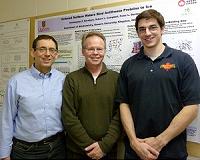 |
Columbia MO (SPX) Apr 15, 2011 Most buildings are not constructed to withstand an unexpected explosion or impact. Now, a researcher at the University of Missouri is working with the U.S. Army to test a method of retrofitting buildings to protect them in the case of a terrorist attack. Sarah Orton, assistant professor of civil engineering in the MU College of Engineering, has focused on using carbon fiber reinforced polymer (CFRP), a fabric that can carry 143,000 pounds of force per square inch and has various applications to strengthen reinforced concrete buildings. CFRP has been used previously to strengthen buildings for earthquakes. "CFRP has been used in places like California since the 1980s to protect buildings from earthquakes, but it has so many applications," Orton said. "Now, we have to worry about damage caused by attacks. This fabric can be a great tool to protect people in threatened buildings." To protect a building from an extreme event, CFRP can be used to increase the bending capacity of walls or columns. Previously, Orton invented an anchor that can be embedded in the column or joint to make CFRP more effective. In that work, Orton found that the anchors allow the CFRP to reach its full tension strength rather than separating from the concrete at only about half its strength. CFRP can be used to protect an entire wall from an explosion. To study the effectiveness of different ways of applying CFRP, Orton worked with the U.S. Army Engineer Research and Development Center (ERDC) to detonate explosives near CFRP-reinforced concrete slabs. She found that CFRP, when layered and anchored, provided a significant amount of protection. However, she said that applying additional protection to the front of the concrete slab, such as a steel plate, would enhance the slab's performance. Orton says the high costs of approximately $30 per square foot have kept CFRP from being widely implemented in non-earthquake prone areas. "This is a really useful material," Orton said. "I continue to be fascinated by the material's strength and applications. Retrofitting buildings with CFRP will help protect people from attacks and potentially collapse of the building." The study, "Use of Carbon Fiber Anchors to Improve Performance of CFRP Strengthened Concrete Structures Subjected to Blast and Impact Loads," will be published in a special publication of the American Concrete Institute.
Share This Article With Planet Earth
Related Links University of Missouri Space Technology News - Applications and Research
 Finding May End A 30-Year Scientific Debate
Finding May End A 30-Year Scientific DebateKingston, Canada (SPX) Apr 13, 2011 A chance observation by a Queen's researcher might have ended a decades-old debate about the precise way antifreeze proteins (AFP) bind to the surface of ice crystals. "We got a beautiful view of water bound to the ice-binding site on the protein," says Peter Davies, a professor in the Department of Biochemistry and a world leader in antifreeze protein research. "In a sense we got a lucky ... read more |
|
| The content herein, unless otherwise known to be public domain, are Copyright 1995-2010 - SpaceDaily. AFP and UPI Wire Stories are copyright Agence France-Presse and United Press International. ESA Portal Reports are copyright European Space Agency. All NASA sourced material is public domain. Additional copyrights may apply in whole or part to other bona fide parties. Advertising does not imply endorsement,agreement or approval of any opinions, statements or information provided by SpaceDaily on any Web page published or hosted by SpaceDaily. Privacy Statement |